The humble bee is a crucial part of the multiple miniature ecosystems that make it possible for nature’s cogs and gears to keep turning and the world to keep running. Take the bee out of the global equation and the effect on humanity and every other living organism on earth would be catastrophic.
We need bees far more than they’ll ever need us, but as much as we rely on them, some species of bees have unique nesting and mating behavior that can be a nuisance in the yard.
One of these misunderstood species (that’s much maligned by homeowners) is the carpenter bee. But first—are you sure you’re dealing with carpenter bees and not their lookalikes?
How to tell a carpenter bee from other bees
Carpenter bees are wood-drilling insects that burrow into wood in order to make their nests. As solitary insects, they don’t live in hives and aren’t part of a complex social group (like honeybees).
They’re one of the largest species of native bees in the United States (a distinction they share with bumble bees) and are often mistaken for bumble bees. But while both are large in size (about 1/2 to 1 inch long), their appearance is quite different.
The carpenter bee is less hairy than a bumble bee. It has a shiny black abdomen, a fuzzy yellow thorax with a bald spot in the middle of its back, and a black head. The male has a white spot on its face.
Read more: An easy visual guide to identifying common bees in your backyard
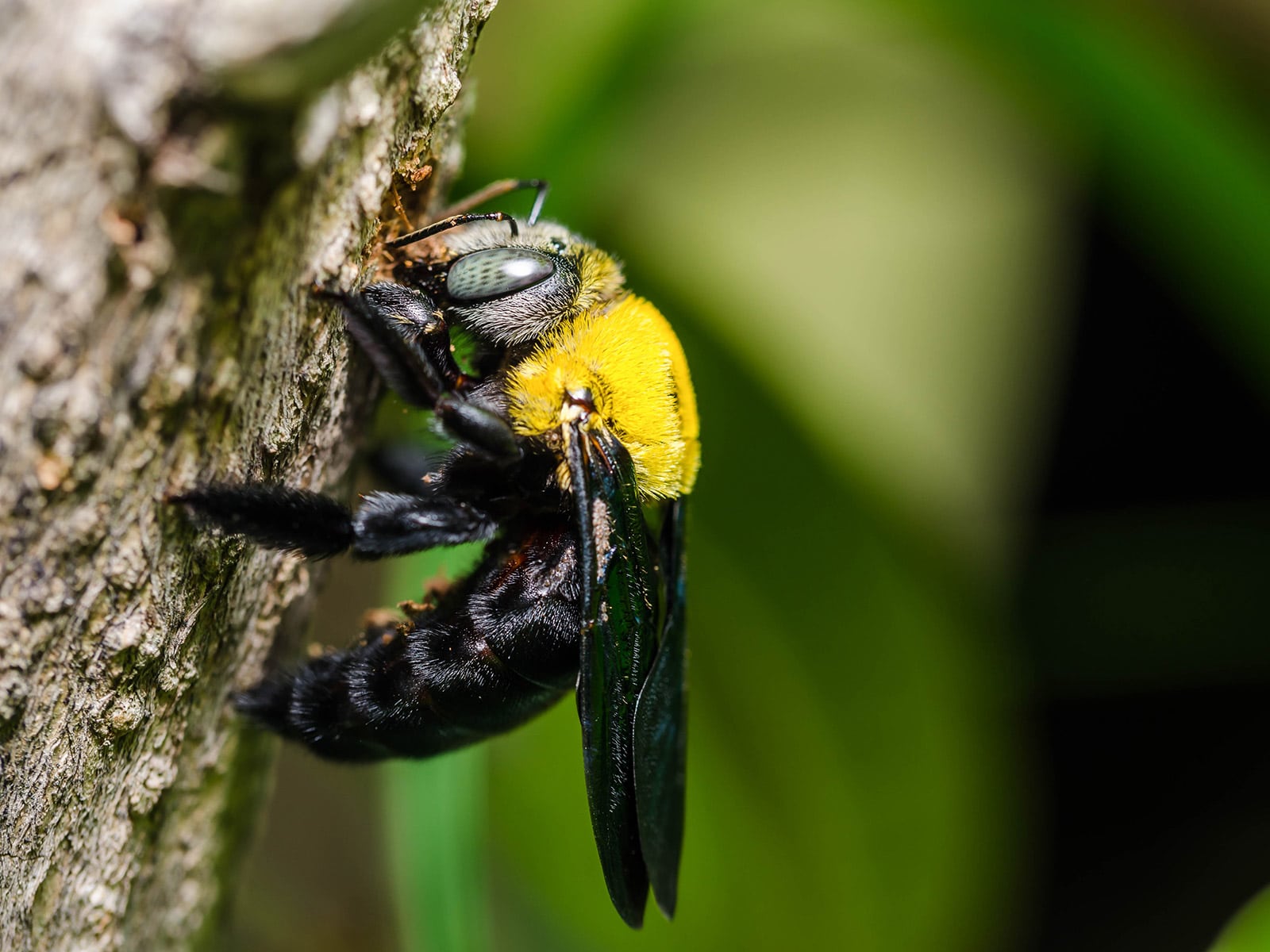
Though they don’t conform to the same social structure that the majority of bee species do, carpenter bees still follow the same hierarchical makeup, and the female always takes the lead.
The female of the species is not defensive or aggressive, but can sting if provoked. Its job is to excavate small tunnels in wood to lay its eggs and raise the larvae to adulthood.
The male, on the other hand, is very aggressive but all talk and no bite—that is, it may attack a potential threat (like other bees, insects, and even humans) but cannot sting. Its job is to guard the entrance of the tunnels (in hopes of snagging a mate).
Carpenter bees aren’t particularly fussy about the places they nest in, which means when spring is in the air and mating season arrives, there’s a pretty good chance that a persistent carpenter bee might choose to make her nest in a rather inconvenient place—like the woodwork around your home.
Effective ways to get rid of carpenter bees (and keep them out)
Carpenter bees are incredibly efficient pollinators and are a vital part of your garden’s ecosystem, and as long as they’re left alone, they pose absolutely no danger to you.
Once they’ve burrowed in, it’s too late to do anything about the bees being there. You’ll need to leave them be and take care of what’s left of their nests after the next generation of bees has hatched and grown.
Therefore, the best way to get rid of carpenter bees is to prevent them from taking up residence in the first place. The following methods I recommend for controlling them are non-toxic and safe to use around children and pets.
Attempting to deal with a bee infestation using pesticides, insecticides, or toxic chemicals should be a very last resort, and avoided if at all possible.
This is not just to help the pollinator population in your yard, but also for health and environmental reasons.
Here’s how you can prevent carpenter bees from staking a claim to your property.
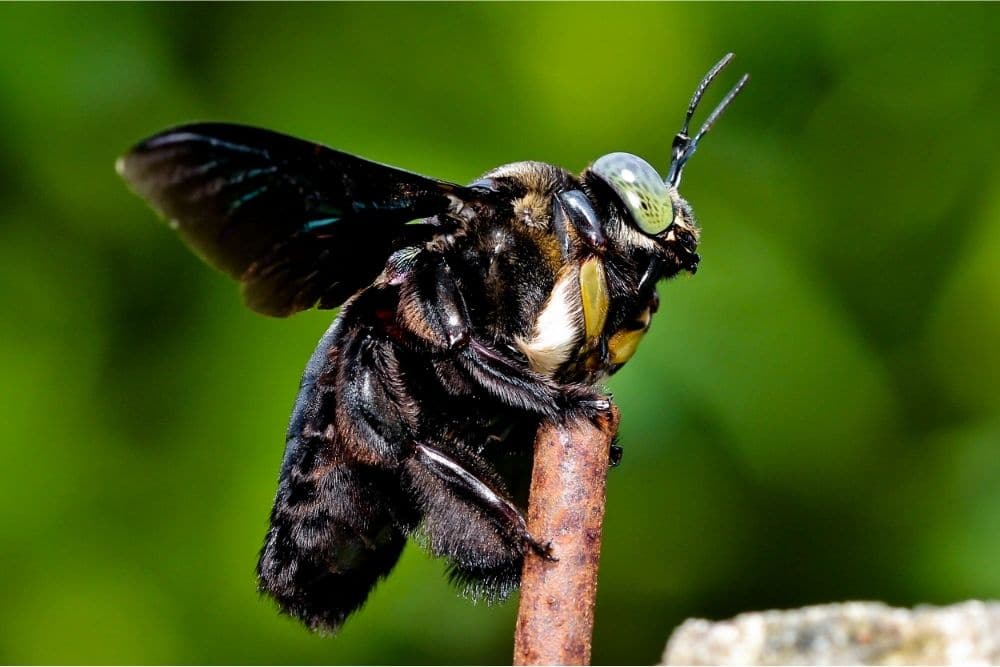
Method #1: Paint your wood.
It sounds crazy, but the simple truth is if you paint your fences, decking, and any other wooden buildings and surfaces that carpenter bees might be tempted to nest in, they’ll move on to somewhere else.
Why? Because carpenter bees are put off by wood that’s been chemically treated (which makes it more challenging to burrow into).
Even a coat of clear varnish (not a wood stain, which does not have the same repelling effect) will deter them from drilling.
Painting is such a simple solution and works so well that it’s always my #1 recommendation for deterring bee nest construction.
Another tip: If you’re building a new structure or replacing any old or damaged wood, use pressure-treated lumber instead of untreated lumber. Or, consider synthetic materials like vinyl, Trex, or HardiePlank if you don’t want the ongoing maintenance of paint.
Method #2: Use citrus essential oil.
Many insects are sensitive to the potent scent of citrus essential oil, carpenter bees included. The strong smells of orange, lemon, lime, lemongrass, bergamot, and grapefruit may be powerful enough to deter them, yet safe enough to use around your home as a natural bee repellent.
Some easy ways to incorporate citrus in your yard include:
- Misting any exposed wooden surfaces in early spring with homemade citrus spray. (You can easily make this by boiling sliced citrus fruit in water for 10 to 15 minutes, then pouring the cooled and strained mixture into a spray bottle.) For best results, spray the surfaces a few times a week for several weeks.
- Placing citronella torches around your deck or patio.
- Planting lots of citrus (or citrusy-smelling herbs, like citronella, lemon verbena, and lemongrass) near your house.
Using citrus as a deterrent can be labor-intensive (especially if you’re making citrus spray a few times a season), so I only recommend this method in tandem with other preventive measures.
Method #3: Install chimes or speakers.
Hanging heavy wind chimes (or anything that will vibrate and make noise when it’s caught in a breeze) in areas where carpenter bees might nest can be effective enough to drive them elsewhere.
It isn’t the sound the chimes make that bothers and distracts bees, it’s the vibration.
In a similar vein, you can even install outdoor speakers around potential problem areas (as long as you remember to turn them on often). The vibration from the sounds coming out of the speakers is enough to disorient the bees and either deter them from nesting, or drive them away from their nests completely.
So put up that outdoor sound system you’ve always wanted and load up your favorite playlists or podcasts!
Disclosure: If you shop from my article or make a purchase through one of my links, I may receive commissions on some of the products I recommend.
Method #4: Seal the holes.
Each new generation of carpenter bees hatches in late summer. The bees emerge from their nests in August and September to feed on nectar and pollinate flowers before overwintering (often in abandoned nest tunnels).
So your best bet for sealing any holes is in late September when most, if not all, the bees have left the nests.
To ensure you don’t trap any stragglers in the tunnels, use a bee repellent like this one. (It’s the same stuff beekeepers use to humanely remove honeybees from the hive so they can harvest the honey.)
Once you’re sure all the bees are out, plug the hole with wood putty or a wooden dowel coated with wood glue. This will prevent female bees from returning to their nests and causing more damage.
One important thing to note: I’ve seen small corks like these ones sold for the purpose of plugging carpenter bee holes, but I don’t recommend them. The bees can and will chew through the cork and make new holes elsewhere. At best, these corks are temporary band-aids if you can’t get around to properly plugging the holes right away.
Important
Always use bee repellent before plugging a hole. If any carpenter bees are trapped inside their tunnels, they’ll simply excavate new tunnels to find their way out.
Method #5: Invite them in.
While carpenter bees can burrow into any wooden area they choose to make a nest in, they can also be rather lazy. Every spring they have the huge task of drilling holes and building nests, so if they can find anything to make their jobs easier, they’ll likely take it.
That’s when a solitary bee house like this one can be an effective remedy for keeping carpenter bees away from your own house.
Mount the bee house on a wall that gets morning light, on a tree branch away from bird feeders, or on a sturdy post in your garden to give carpenter bees an alternate and ready-made nesting site!
When choosing a bee house, make sure the holes are large enough for a carpenter bee to nest in. Many of the ones on the market are made for smaller solitary bees (like masons), and carpenter bees won’t fit inside the pre-drilled holes, nor do they like the more common bee houses filled with paper nesting tubes.
Method #6: Trap them.
When all else fails, or if you have other reasons for needing to exterminate carpenter bees around your house, you can use a special carpenter bee trap.
Where to buy
Carpenter bee traps
Hang this type of trap on a fence post or near existing holes around your house to lure carpenter bees. Once they fly inside the trap, they fall into a chamber and cannot fly back out.
You can use a non-toxic bee trap lure around the trap entrance to further bait them. The lure replicates bee pheromones and is 100 percent safe to use, unlike pesticides that are toxic to other beneficial insects as well as humans.
Where to buy
Bee trap bait
Hang the trap under an eave or covered porch (or wherever carpenter bees are likely to nest) and discard the dead bees when they start piling up in the jar.
How their holes are made
Unlike termites—and contrary to popular belief—carpenter bees don’t eat wood. They forage for pollen and nectar.
Read more: Keep pollinators around by planting nectar-rich flowers that bees love
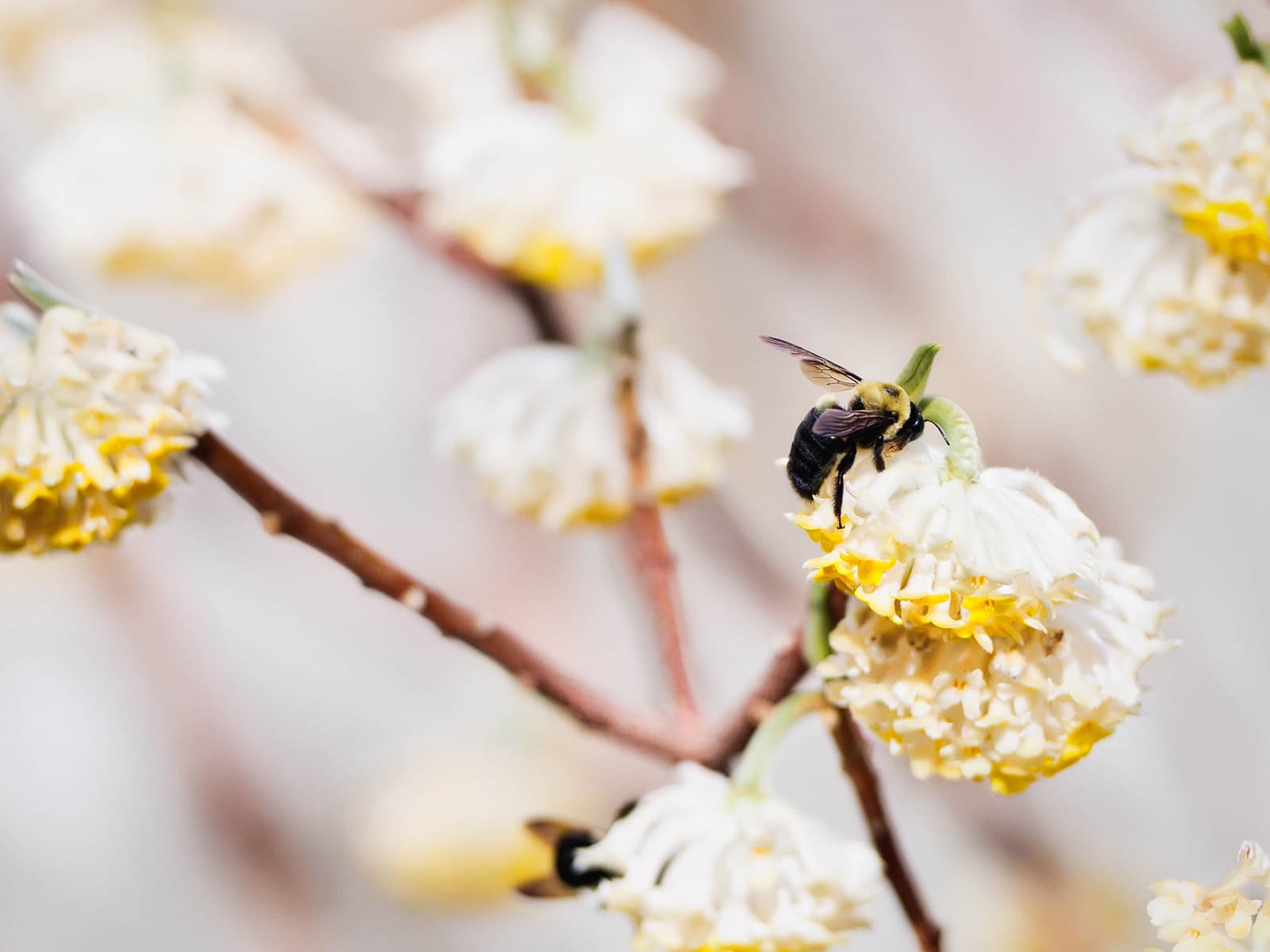
But they do chew through wood (and spit the particles back out) to build their nesting chambers, an activity that can be loud, messy, and a nuisance on your property.
The easiest way to tell if you’ve been visited by carpenter bees is if you start seeing small, random piles of sawdust or loose shavings around the wooden surfaces outside your house—particularly sawdust near or directly beneath tiny holes.
You might hear some muffled buzzing inside the wood (as the bees bore their tunnels) and you might even see some large, lightly fuzzy bees flying around your wooden eaves, wooden fencing, or wooden deck.
Those little mounds of sawdust are byproducts of the bees’ burrowing. And where there’s sawdust, there’ll almost certainly be holes.
To know whether these are just random holes or the skillful work of carpenter bees, look for sticky, dark, yellowish-brown or black stains around the holes; these are bee droppings (excrement). The holes are about 1/2 inch in diameter and perfectly round, to where you might even mistake them for holes drilled by a power tool.
Carpenter bees prefer to drill into unpainted softwoods like pine, cypress, fir, cedar, and redwood. (Though some species will also drill into hardwoods like oak or eucalyptus.)
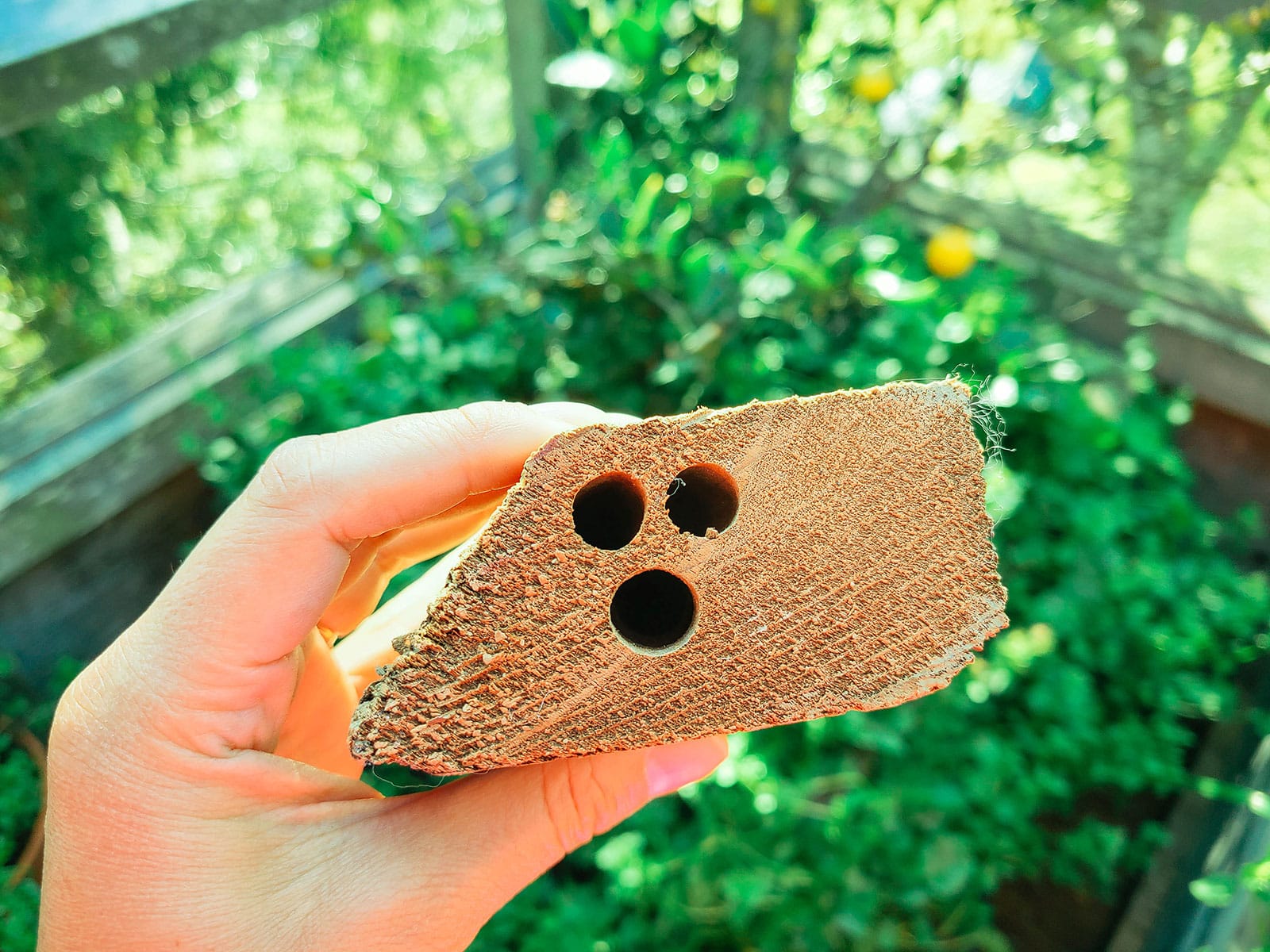
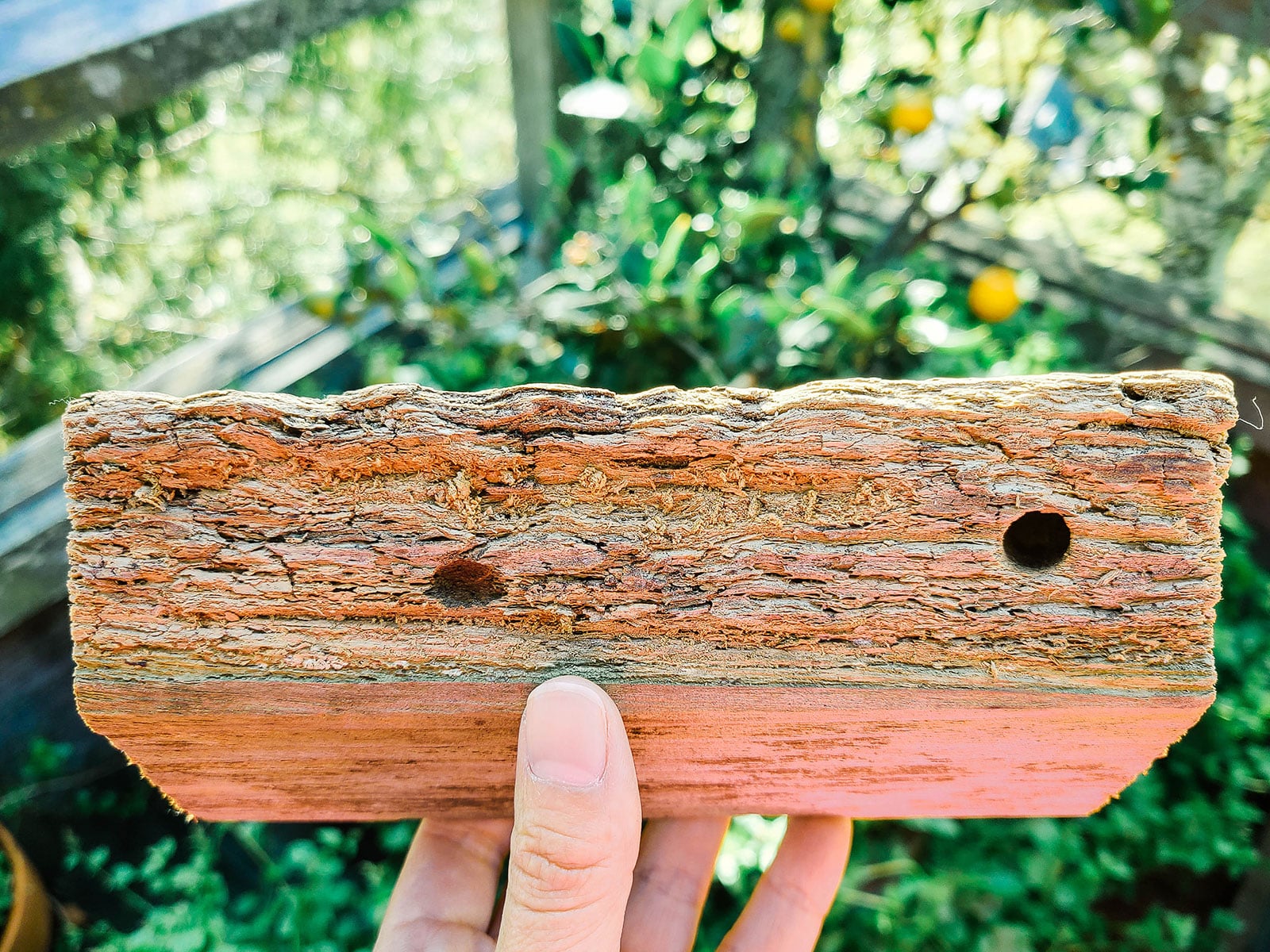
Their holes are usually found in wooden roof shingles, fascia boards, eaves, rafters, siding, decks and railings, fence posts, firewood, and outdoor furniture. In the wild, they often make nests in dead trees, stumps, and logs.
It’s not just the hole you have to worry about
From the outside, carpenter bee damage looks like a simple hole. But the hole is merely an entrance to a network of branching tunnels built by multiple bees.
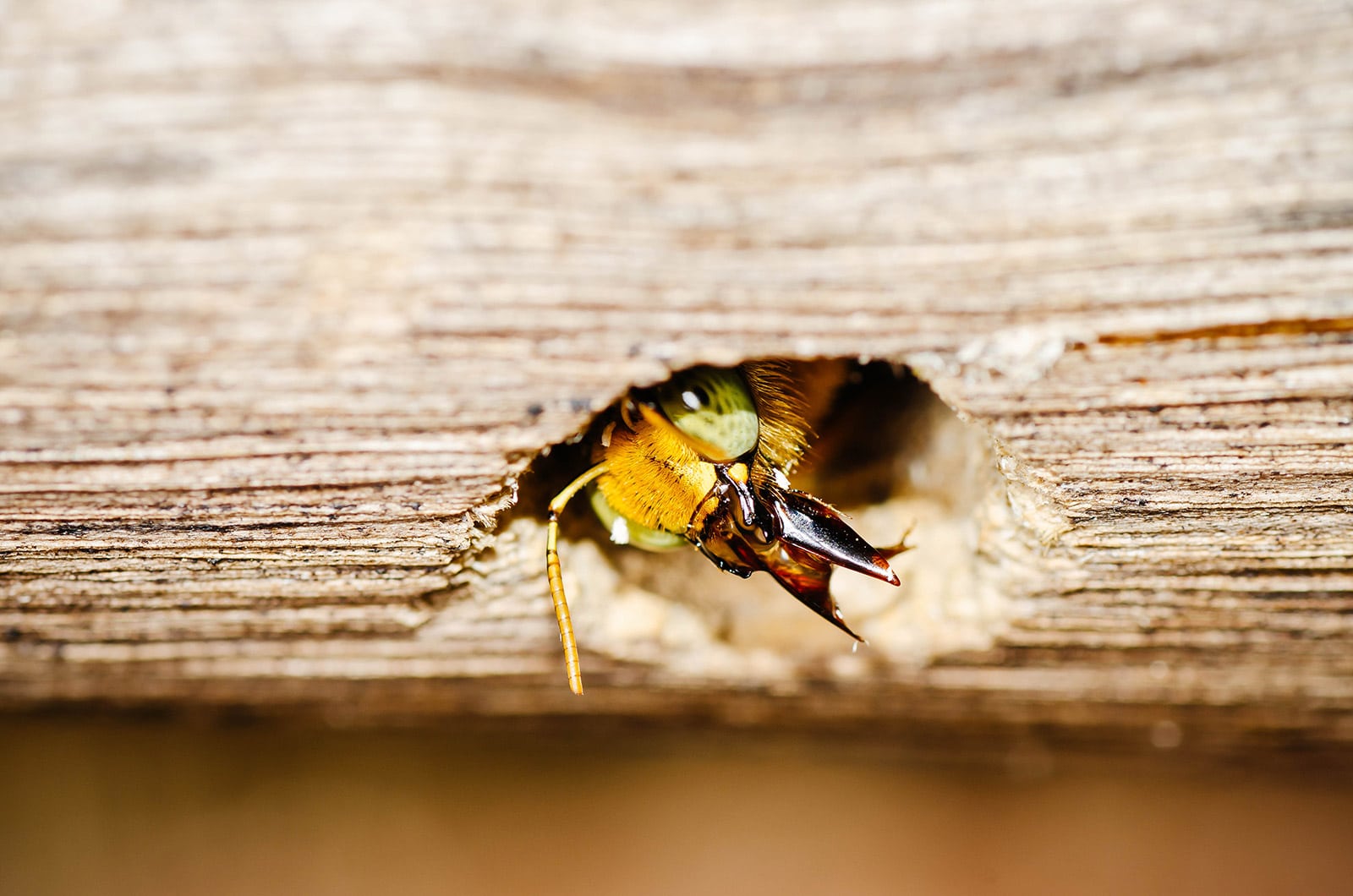
The female carpenter bee starts by using her mandible (mouthpart) to vibrate against the wood grain, carving out small granules that resemble sawdust. It goes about a half-inch into the wood, then makes a 90-degree turn and “drills” a long tunnel following the grain of the wood. A single tunnel is typically about 6 inches long but can span up to 12 inches.
The female can bore a little over a half-inch of wood per week and sometimes you can even hear it chewing furiously through the wood.
One hole can be used by multiple nesting females, with each bee having its own tunnel branching off the main one. Inside each tunnel are 6 to 10 cells. The female mixes pollen and nectar to form a kind of “bee bread,” lays an egg on top of the bee bread, then seals off each cell with chewed-up wood.
Since the female likes to keep a clean nest, it pushes all the excess wood granules and its own poop out of the tunnel, resulting in the piles of sawdust and sticky streaks of brown you see outside the holes.
On its own, a single tunnel bored by a carpenter bee isn’t likely cause to cause any significant damage to your home or other wooden structure. The initial drilling may not be aesthetically pleasing, but it won’t compromise stability.
However, female carpenter bees prefer to use the same nesting sites as their mothers, and may return to their nests to overwinter before enlarging and expanding the tunnels the following spring.
If the same tunnel is used by multiple carpenter bees over multiple years, it can stretch up to 10 feet long, severely weakening the wood.
Woodpeckers also like to feed on carpenter bee larvae and will cause further damage by tearing into the wood to get at the nests.
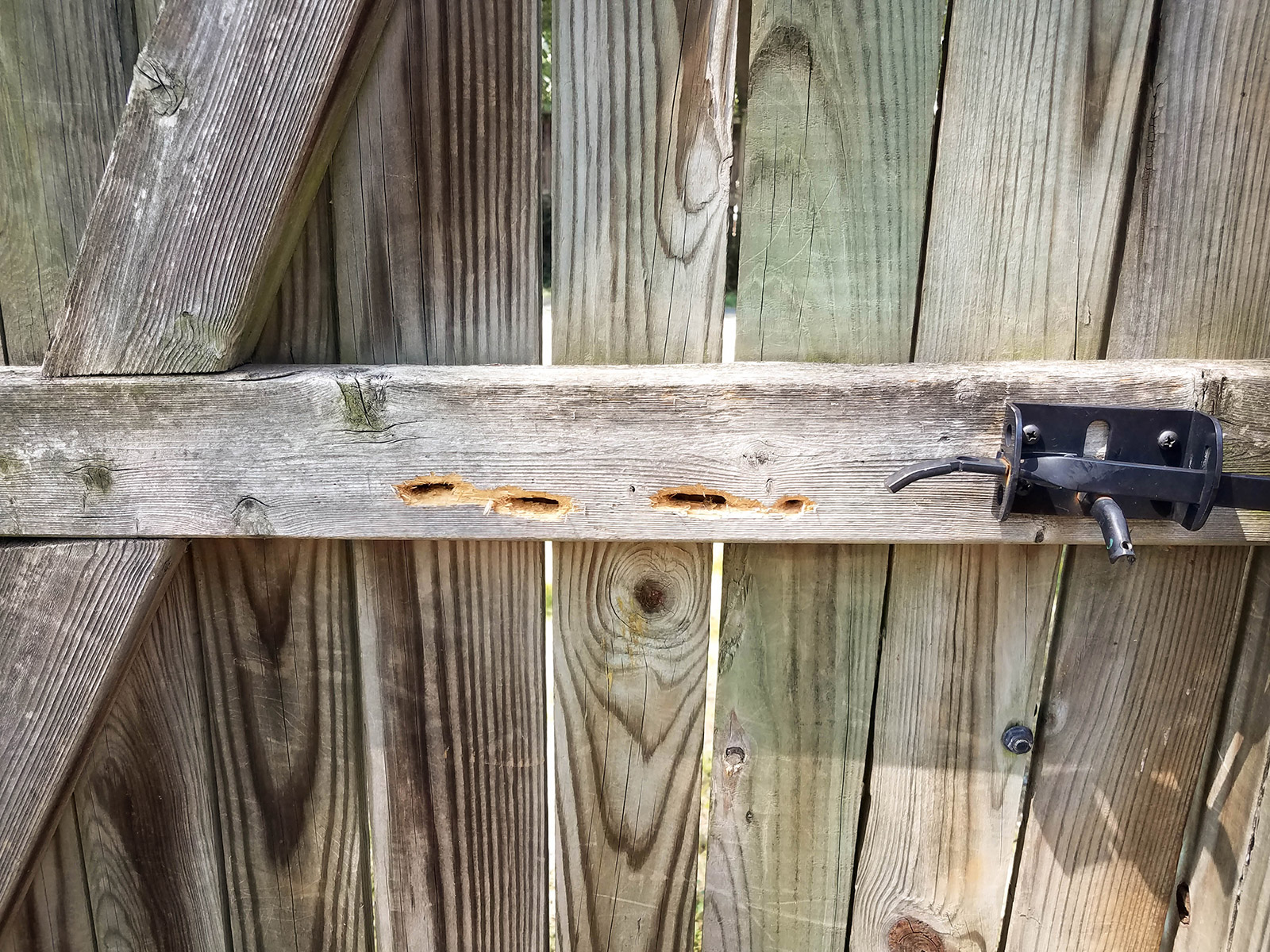
Multiple holes also create more areas for water to seep in, eventually leading to wood rot. So, it’s always a good idea to put a stop to carpenter bees as soon as you notice them burrowing on your property.
More posts you might find helpful:


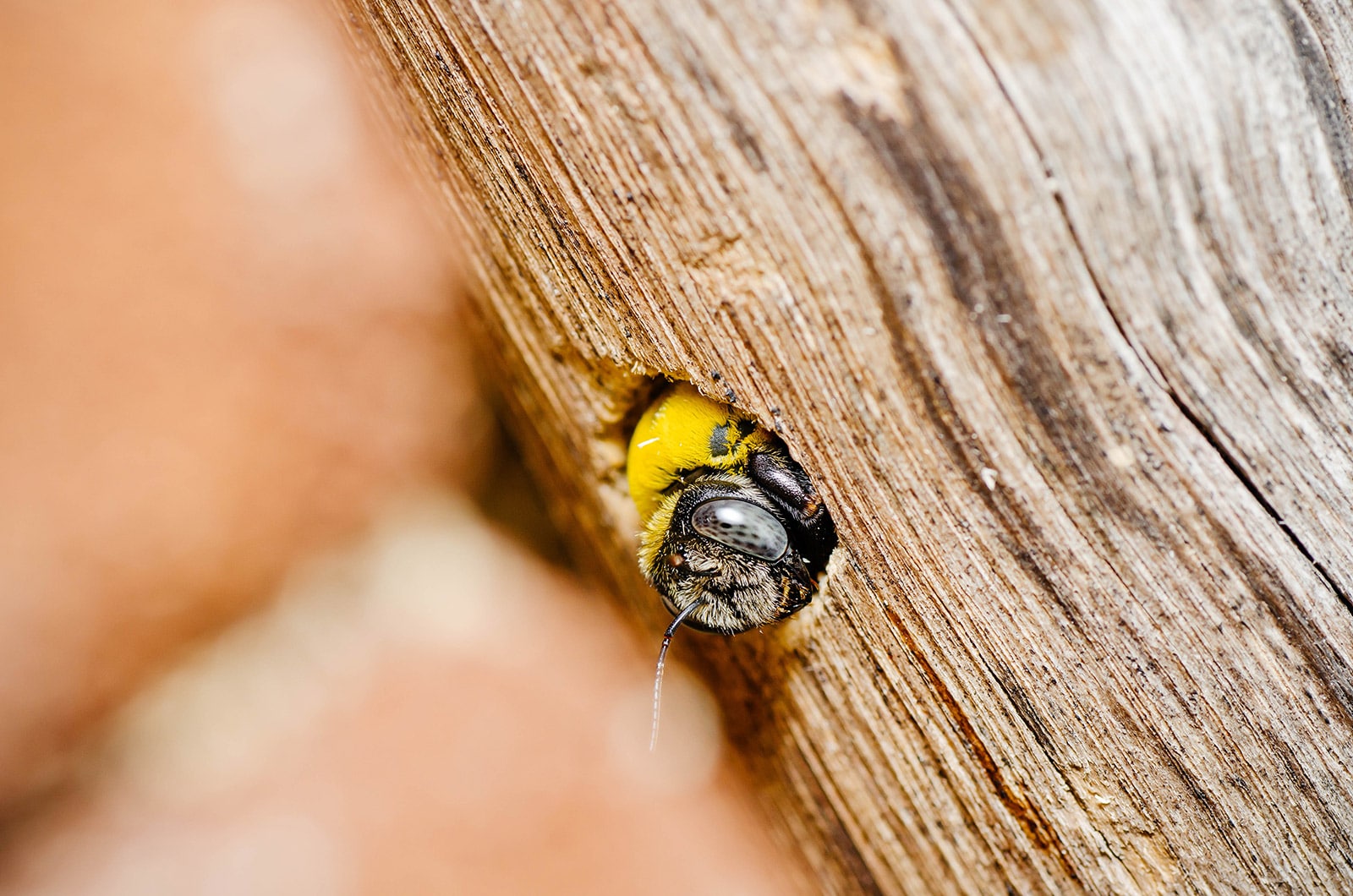













Do we have to have the exterminator treat our house MULTIPLE times in ONE season? One contracter told me ONLY once and the other told me multiple times! I am confused. They are getting under the aluminum siding of our house. I guess that I will have to get a contractor to seal the areas before September? We live in North East NJ. ?
A box fan works great at keeping them away. If placed close enough to the site where they like to bore holes, it will prevent them from being able to get close.
I hang inflated paper bags. They think they are hornet nests and go away.
Traps work for a few, treated wood I think just invites them , wind chimes is a no I have four chimes on porch right where they are boring holes , tried clogging hole and they will go right next to it and start new one. I’ve resorted to swatting and killing because they are drilling holes on my exposed wood, we have covered as much as we can with metal.
Bee traps work but it won’t solve your problem completely. All it does is help keep the population down and I have seen an occasional bee find his way out but very rare.
I hang a brown paper bag on my painted trellis. Carpenter bees.think this is a hornets nest and will move on.
Windchimes don’t work. Painting doesn’t work. Might catch in glue trap. House type traps don’t appear to have lg enough hole for them to enter. Will kill them anyway I can to keep from rebuilding my porch.
There is no hope. Latex paint won’t work.
Buy some badminton tennis racquet thing’a-ma jiggers and whip ’em. Trap what you can. BB guns or air soft might work
Carbonator cleaner or wd-40 has the straw nozzles that will fit in their holes. One quick squirt will get them out (eventually). I wouldn’t recommend the spray foam or painter’s caulk. Silicone might do the trick. Best luck iv had is WD-40 n mash em when they come out.
Amen that’s what we do. They are just enormous termites!!!! After 20 years you wonder about the wood in your home being so damaged. We have tried everything, but they just burrowed themselves an exit hole causing more damage!!!! Ugh!! I was told after they leave their larva then they use that spot like a turtle comes back to lay it’s eggs at the same beach.
First down to earth and funny post on this topic I’ve seen 🤔😁🫡
I live in the deep south. We use cedar traps that have holes bored into a block of wood with a mason jar. Screwed to the bottom. It’s a catch, relocate and release method. I would recommend these first over citrus essential oil as lime juice and oil are a strong pesticide
Stained or painted wood does not always deter them, they can find ways around it.
I used to live in a cedar sided house. It was sealed and they still found a way.
I was told as a kid to leave them bee (pun intended) but to watch out for the ones with the white dot on their head. They’re typically the aggressive ones.
All in all they are still a pollinator and good to keep around.
How far away do you have to release them, in order for them to not return?
250 miles, generally north to northeast from where you live. The prevailing westward winds will “push them” towards the east coast. Eventually they will be pushed out over the Atlantic Ocean and drown. Most boats and ships are made from steel or fiberglass. They cannot chew through that.
Good luck!
You really think bees will just allow themselves to be pushed out over the ocean, like some sort of forgotten balloon?
If they are not interested in finding a way to return to where you caught them, they will just make a new nest where you released them. Carpenter bees really are lazy bees, and, unlike other bees, likely will not travel more than a few miles back. A carpenter bee released 10+ miles away is likely to find another home.
I love the bee house idea. I just bought one to give them a yes, and then I will try the other techniques to dissuade them from where I don’t want them (my attic!). Do you have any similar recommendations for wasps? Last year, we moved into a new house and about a month in wasps started to move into a spot between the desk levels. They never bothered us, and were not aggressive. But because they were borrowing into our house, we had to get rid of them. I would like a more humane way to do this in future, because I know it will come up again.
Unfortunately I don’t have a solution for wasps as we have to remove any nests we find near our house. I’ve seen fake nests (usually knitted ones) that you can hang under your eaves and other locations to try to discourage them from building nests, but don’t know how effective they are.
Tori,
If you need to exterminate wasps quickly and humanely, fill a one gallon sprayer with water and add a cup of Dawn liquid dish soap. Shake the sprayer to mix well and you can spray a nest from a safe distance. The soapy water will quickly kill the wasps. The more soap, the faster the death of the wasp.
It will also kill carpenter bees if all else fails.
Just a note, when we lived in Virginia every carpenter bee nest we found was in pressure treated, painted or stained wood and that was in several locations literally surrounded by trees. My experience is painting or using pressure treated wood is not at all a deterrent.
Thank you thank you thank you for writing this! we are having a huge issue with carpenter bees in the tree in front of our home and worrying about branches being weak and eventually having to take our tree down.